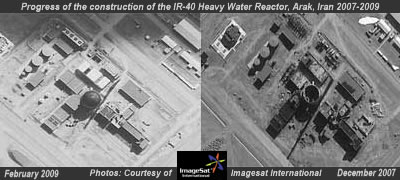A satellite image obtained by Defense Update clearly shows the advanced stage of construction at this site. The image was taken by Imagesat International Eros B satellite in mid-February 2009. The site has been monitored by satellite imagery since the beginning of the construction at the site in 2005. Most recently, construction has been progressed, with roofing being completed for supporting facilities and the construction of the reactor building’s domed containment structure has also been completed.
According to International Atomic Energy Agency (IAEA) officials, the advanced stage of construction renders the continued use of satellite imagery impossible, in order to monitor further construction inside the reactor or any of the other related buildings. The site is located at the premises of Iran’s heavy water production plant, commissioned in August 2006. According to a recent IAEA inspection, this fuel manufacturing plant is already operational. The process line for the production of natural uranium pellets for the heavy water reactor fuel had been completed and fuel rods were being produced at the site.
The planned reactor, the IR-40, will have a power of 40 megawatts thermal (MWth) and use natural uranium oxide fuel, which will be made at Esfahan. Construction is scheduled to be complete in 2011 and the reactor will achieve critical stage in 2013. If operating optimally, the reactor at Arak would produce about 9 kilograms of Pu-239 (plutonium) annually – enough to build one nuclear weapon every year. However, plutonium is not produced directly from the reactor, and will be separated in yet another facility before being ready for weaponization. Therefore, Iran is expected to be capable of producing its first plutonium based weapon by the middle of the next decade. Iran says its reactor at Arak will be used to produce isotopes for peaceful purposes. However, such a facility is far more powerful for such benign purposes. Much smaller, light-water research reactors are fully satisfactory for the kinds of applications Iran claims it is interested in. It is noteworthy that France, Germany, and the United Kingdom offered to replace Iran’s 40-megawatt heavy-water reactor with a light-water research reactor, but Iran was not interested in that offer.

















